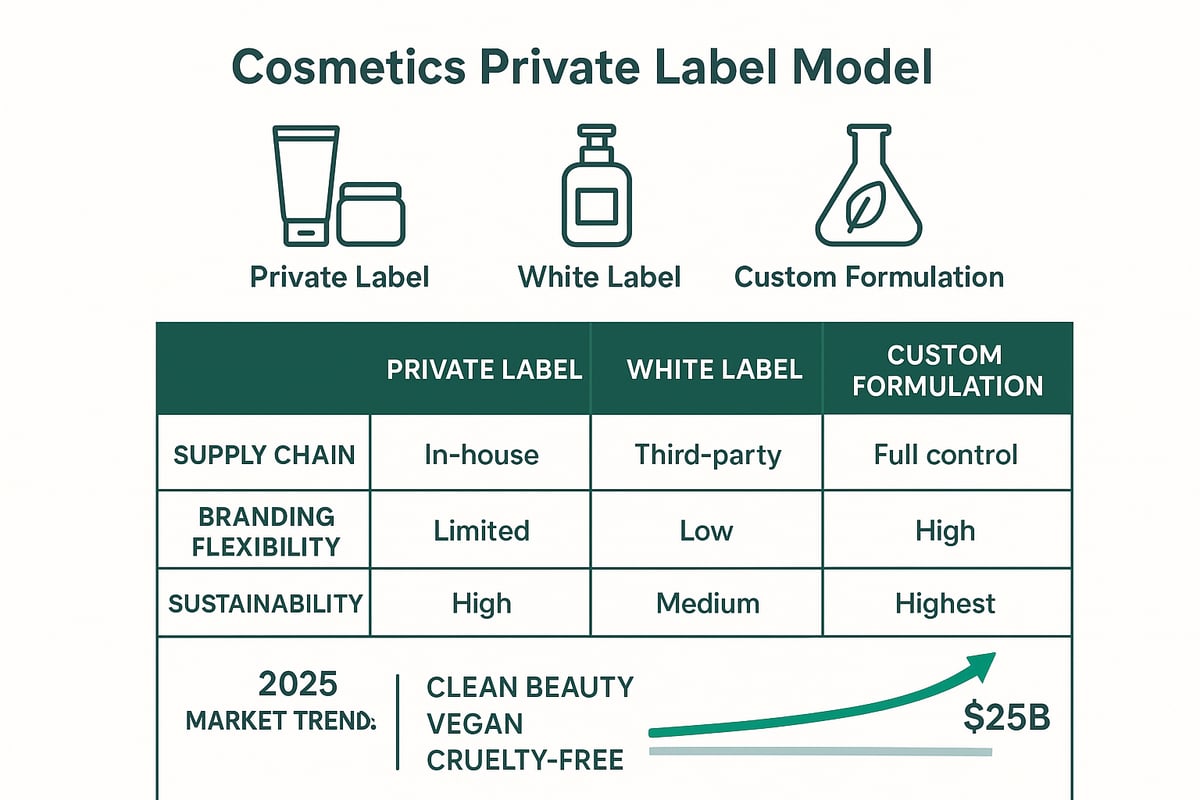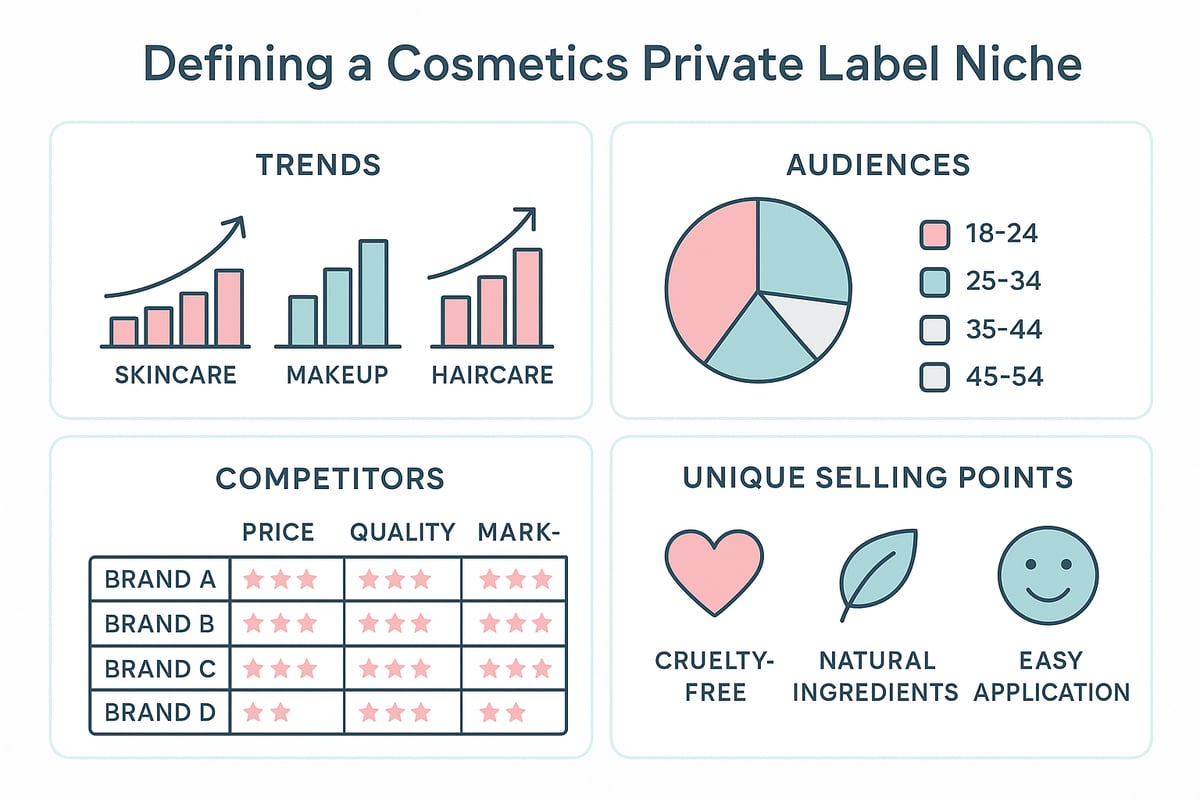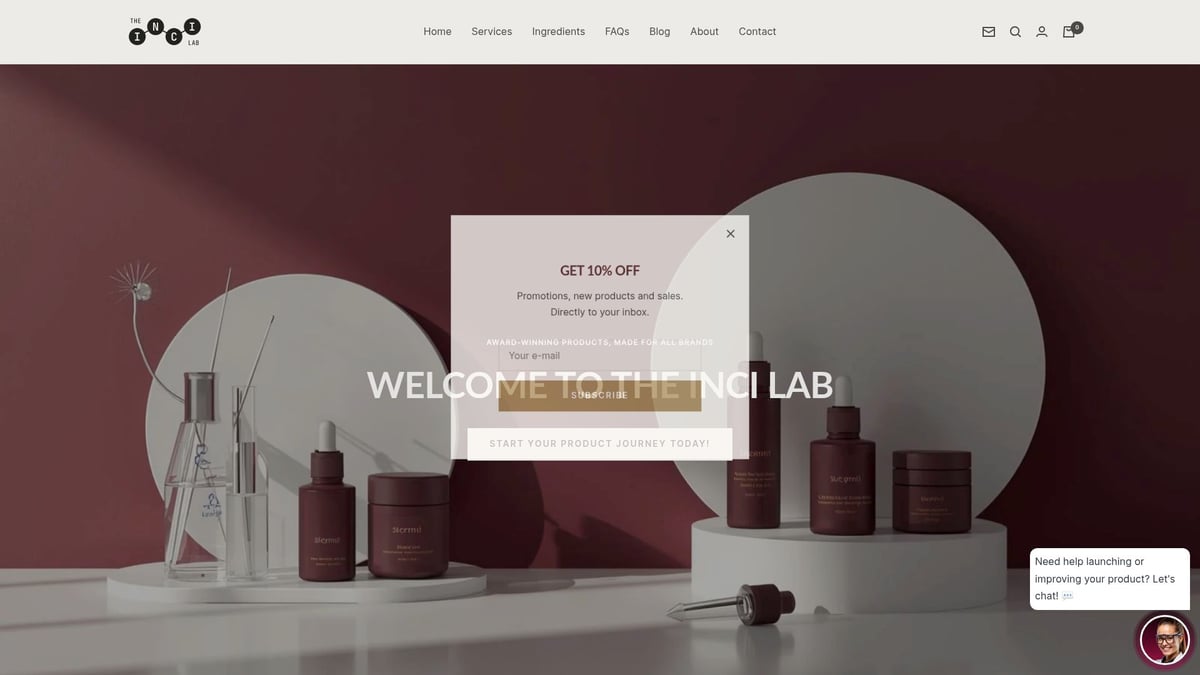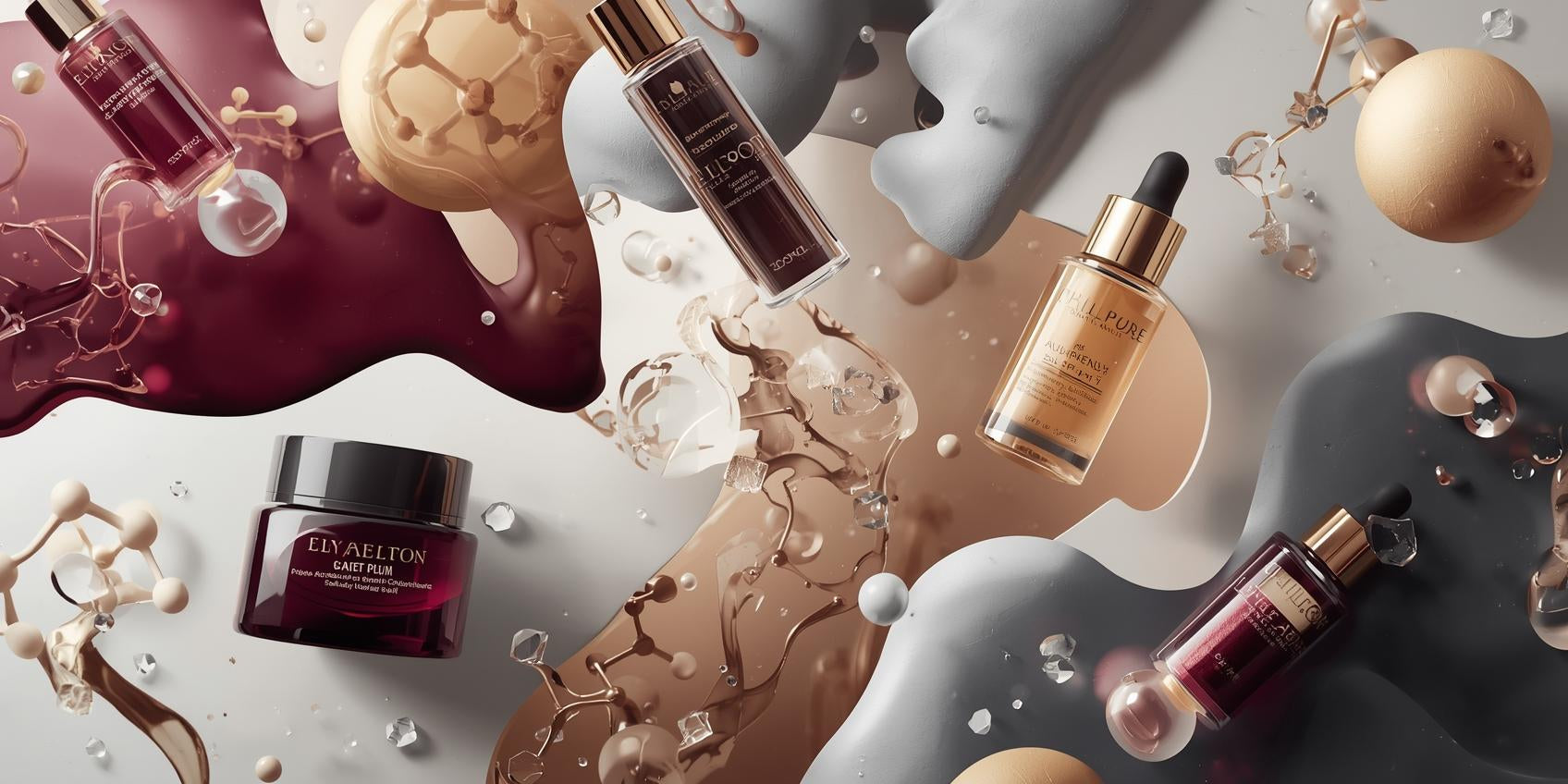The global beauty industry is on a record-breaking trajectory, with private label cosmetics expected to reach new heights in 2025. This surge creates unprecedented opportunities for entrepreneurs and established businesses alike.
If you have ever dreamed of launching your own cosmetics private label brand, this guide is your roadmap. You will learn how to research your niche, select the right manufacturing partners, understand regulations, and create products that stand out in a crowded market.
Ready to turn your vision into reality? Explore expert insights, proven strategies, and actionable steps designed to help you build a successful cosmetics private label brand from the ground up.
Understanding the Cosmetics Private Label Model
What is Private Label in Cosmetics?
Cosmetics private label refers to the practice where businesses sell beauty products manufactured by a third party under their own brand name. Unlike white label products, which are generic and sold to multiple brands with minimal differentiation, private label allows for more customization in packaging and branding. Custom formulation, on the other hand, involves creating entirely unique products from scratch.
This model offers entrepreneurs and established brands several benefits, such as lower upfront investment and the ability to quickly enter the market. Some successful cosmetics private label brands have built strong identities by leveraging this flexibility. The global rise of private label cosmetics is fueled by growing consumer demand for affordable, high-quality alternatives to legacy brands.
Advantages and Challenges of Private Labeling
Choosing cosmetics private label offers lower entry barriers and significantly reduces research and development costs. Brands can select from a range of ready-made products, allowing for rapid brand launches and flexible product selection. This approach often leads to higher profit margins, as costs are controlled and branding can command premium pricing.
However, there are challenges to consider. Minimum order quantities can be a hurdle for smaller brands, and customization options may be limited compared to full custom development. Supply chain risks, such as raw material shortages, can impact production timelines and pricing. Recent disruptions have shown that cosmetics private label brands must be agile to adapt to changing market conditions and maintain steady inventory.
Private Label vs. Custom Formulation: Which is Right for You?
When comparing cosmetics private label with custom formulation, several factors come into play. Private label is ideal for businesses seeking a fast time to market and lower investment, as products are pre-developed and only require branding adjustments. Intellectual property typically remains with the manufacturer, which means less control over formulations.
Custom formulation, while more resource-intensive, grants full ownership of unique product recipes and can help brands stand out with exclusive offerings. The decision depends on your goals: choose cosmetics private label for speed and simplicity, or opt for custom formulation to carve out a distinct market position. Case studies show fast launches succeed with private label, while innovation leaders often invest in custom solutions.
| Aspect | Private Label | Custom Formulation |
|---|---|---|
| Time to Market | Fast | Longer |
| Investment Required | Lower | Higher |
| IP Ownership | Manufacturer | Brand |
| Customization | Moderate | Extensive |
Key 2025 Trends in Private Label Cosmetics
The cosmetics private label sector is rapidly evolving as consumers prioritize clean beauty and sustainability. There is a growing demand for vegan, cruelty-free, and paraben-free products, with brands expanding inclusive shade ranges to cater to diverse audiences. Technology-driven packaging, such as refillable containers and smart labels, is enhancing both user experience and eco-friendliness.
E-commerce integration and customizable beauty solutions are also gaining traction, enabling brands to reach wider audiences and personalize offerings. According to the Private Label Cosmetics Market Growth & Trends, the global market is projected to continue its robust expansion in 2025, driven by these consumer preferences and innovative business models.

Step 1: Research & Define Your Niche
Launching a successful cosmetics private label brand begins with thorough research and a clear niche strategy. Defining your market position sets the stage for every decision that follows, from product selection to branding and growth.

Identifying Profitable Niches in 2025
Choosing the right niche is vital in the cosmetics private label market. In 2025, popular categories include skincare, makeup, haircare, and innovative hybrid products. Trends like functional beauty, wellness-driven solutions, and eco-friendly ingredients are driving consumer interest.
Examples of trending products are vegan concealers, talc-free pressed powders, and botanical lipsticks. Use market research tools to analyze demand and spot gaps in the market. Study case studies of brands that focus on specific niches, such as clean beauty or inclusive makeup ranges, to understand what sets them apart.
Understanding Your Target Audience
Knowing your target audience ensures your cosmetics private label products meet real needs. Segment your market by demographics (age, gender, income) and psychographics (lifestyle, values, beauty routines). Identify consumer pain points, such as sensitive skin or a lack of shade inclusivity.
Inclusivity is increasingly important, with consumers seeking brands that cater to diverse skin tones and ethical standards. Social media platforms are powerful tools for gathering audience insights and testing product ideas. For example, clean beauty enthusiasts often prioritize ingredient transparency, while professional makeup artists look for performance and variety.
Competitor Analysis & Benchmarking
A deep dive into competitor brands is essential for any cosmetics private label strategy. Identify both direct competitors (other private label brands) and indirect ones (established legacy brands). Study their product offerings, pricing, and marketing approaches to find strengths and weaknesses.
Use benchmarking to compare product quality, innovation, and customer experience. For example, analyze how Radical Cosmetics positions its private label range and what differentiates its approach. For a comprehensive overview of manufacturing partners and competitive landscapes, review resources like the Private Label Cosmetics Manufacturers guide.
Setting Clear Brand Goals & USPs
Defining your brand’s mission and vision is crucial for long-term success in cosmetics private label. Craft unique selling propositions, such as being clean, cruelty-free, or highly customizable. Align your product claims, like “paraben-free, made in the USA,” with what your target consumers value most.
Set measurable goals for your launch, such as reaching specific sales targets or building a loyal community. Examples of compelling brand positioning include statements like “Ethical beauty for every skin tone” or “Innovation meets sustainability.” Clear goals and USPs will guide your brand’s growth and help you stand out.
Step 2: Product Selection & Formulation
Selecting the right products and formulation strategy is pivotal for a successful cosmetics private label launch. This stage shapes your brand’s identity and market appeal, ensuring every detail from product type to packaging aligns with consumer expectations and industry standards.
Choosing Your Initial Product Line
Deciding on your first range is a crucial step for any cosmetics private label venture. Start by assessing current market gaps and analyzing consumer demand in categories like makeup, skincare, or innovative hybrid products.
Evaluate the complexity of products such as concealers, pressed foundations, lipsticks, and eyeshadows. Offering a variety of shades, finishes, and formats can help your brand stand out. For example, high-intensity eyeshadows and buildable coverage foundations are trending among niche brands.
Consider launching with standout items like vegan concealers or talc-free powders, which cater to growing health and ethical concerns. Select products that align with your brand’s mission and have proven demand in your target market.
Understanding Formulation Options
When developing a cosmetics private label line, you must choose between stock and custom formulations. Stock options let you launch quickly with proven, stable recipes, while custom formulations offer the chance to create a unique market identity.
Ingredient trends are shifting, with more brands opting for vegan, cruelty-free, talc-free, and botanical-based formulas. Regulatory compliance is crucial, so always check ingredient lists against FDA or EU guidelines.
Quality assurance is vital. Ensure products undergo proper testing and certifications to protect your reputation and customers’ safety. For inspiration, review competitor ingredient lists and certifications to benchmark your offerings.
Sourcing and Working with Manufacturers
Selecting the right manufacturer is foundational for your cosmetics private label strategy. Key criteria include minimum order quantities, lead times, customization options, and regulatory compliance.
Ask potential partners about their ingredient sourcing transparency, as this impacts both product quality and consumer trust. Be aware of supply chain risks such as raw material shortages or pricing fluctuations, which can affect your ability to deliver consistent products.
Building strong relationships with reliable suppliers helps minimize disruptions. Always communicate clearly about expectations, timelines, and quality standards to create a seamless production process.
Packaging and Branding Decisions
Packaging is your first opportunity to make a lasting impression in the cosmetics private label space. Choose sustainable and visually appealing packaging to support your brand’s values and attract eco-conscious consumers.
Decide between customizable packaging or standard options based on your budget and brand goals. Key branding elements include your logo, color palette, and product names, all of which should convey your brand’s story.
Make sure all packaging complies with regulatory requirements, such as INCI labeling, claims, and warnings. For example, eco-friendly compacts and clear clamshells are popular choices for eyeshadows, enhancing both aesthetics and sustainability.
How to Work with a Cosmetic Formulation Lab
Partnering with a formulation lab brings innovation and full intellectual property ownership to your cosmetics private label brand. These labs guide you from ideation and ingredient selection to testing and production, ensuring every product is tailored to your vision.

Labs like The INCI Lab support both startups and established brands, providing expertise in sustainability and compliance. To understand the full process and advantages of custom formulations, explore the Custom Cosmetic Formulation Guide.
Collaborating with a formulation lab ensures your products meet the latest industry standards while allowing you to create unique, standout offerings for your audience.
Step 3: Navigating Regulations & Compliance
Launching a cosmetics private label brand in 2025 means navigating a complex regulatory landscape. Whether targeting the US, EU, or other markets, compliance is essential for legal operation and consumer trust. Let us break down the key areas every cosmetics private label entrepreneur must master.

Regulatory Overview by Region
Understanding regulations for cosmetics private label products is vital. In the US, the FDA regulates cosmetics under the Federal Food, Drug, and Cosmetic Act. The EU enforces the Cosmetic Regulation (EC) No 1223/2009, which is stricter on ingredient restrictions and labeling.
Key documentation includes:
| Document Type | Purpose | Required in |
|---|---|---|
| SDS | Safety Data Sheet | US, EU, Asia |
| COA | Certificate of Analysis | US, EU, Asia |
| PIF | Product Information File | EU |
Recent updates include tighter controls on allergens and color additives. For small businesses launching a cosmetics private label brand, the FDA's Small Businesses & Homemade Cosmetics Fact Sheet is an invaluable resource for understanding requirements and avoiding costly mistakes.
Product Safety, Testing, and Claims
Ensuring product safety is critical for every cosmetics private label launch. Brands must conduct stability, microbiological, safety, and efficacy testing before products reach the market.
Validating claims, such as "cruelty-free" or "vegan," requires substantiation and often third-party certification. Certifications like Leaping Bunny or Vegan Society can set your cosmetics private label products apart and build consumer trust.
Handling recalls and adverse events quickly is essential for maintaining brand reputation. For example, competitor brands highlight "paraben-free" and "talc-free" claims, which require documented proof and ongoing batch testing.
Intellectual Property Considerations
Protecting your cosmetics private label brand means securing trademarks for your brand and product names. If you develop custom formulations, seek full intellectual property ownership to prevent copycats.
Understanding the difference between white label and cosmetics private label IP rights is crucial. With private label, you may not own the formulation, so clarify terms with your manufacturer. Avoid infringement by conducting a thorough trademark search and documenting all proprietary information.
Full IP ownership can serve as a major competitive advantage, giving your cosmetics private label brand control over innovation and market positioning.
Managing Supply Chain Risks
Supply chain disruptions can affect production timelines and costs for any cosmetics private label brand. Raw material shortages, shipping delays, and price fluctuations have become more common.
Mitigate risks by:
- Diversifying suppliers to avoid single points of failure
- Building flexibility into inventory planning
- Communicating transparently with customers about any delays
Competitors, such as Radical Cosmetics, openly notify clients about supply and pricing changes, enhancing trust. Proactive risk management ensures your cosmetics private label business remains resilient and responsive to market shifts.
Step 4: Branding, Marketing & Launch Strategy
Launching a cosmetics private label brand in 2025 requires more than great products. Success hinges on a thoughtful approach to branding, marketing, and delivering an exceptional customer experience. Every stage, from your story to your online presence, matters. Here’s how to make your cosmetics private label stand out in a competitive market.
Building a Strong Brand Identity
Your brand identity shapes how consumers perceive your cosmetics private label in a crowded beauty market. Start with a compelling story and mission that reflects your core values—think clean, ethical, and inclusive. Develop a consistent visual language with a memorable logo, color palette, and packaging that aligns with your audience’s expectations.
Ensure your packaging and labeling meet regulatory standards. Familiarize yourself with guidelines such as ISO 22715: Cosmetics Packaging and Labeling, which standardizes essential packaging information for cosmetics private label products globally.
Use your brand pillars—such as “Vegan,” “Cruelty-Free,” or “Made in the USA”—to foster emotional connections and trust. Remember, a strong brand identity is the foundation for lasting growth.
Marketing Channels and Launch Tactics
Selecting the right marketing channels is crucial for cosmetics private label success. Direct-to-consumer (DTC) e-commerce, retail partnerships, and online marketplaces each offer unique advantages. Start building excitement pre-launch by collaborating with influencers, teasing products on social media, and creating waitlists to drive anticipation.
Leverage launch events, PR outreach, and sampling campaigns to generate buzz. Encourage user-generated content and reviews to build credibility and word-of-mouth. Stay agile by keeping an eye on trends outlined in the 2025 Cosmetics Trends Report, which highlight emerging consumer preferences and innovative marketing techniques for cosmetics private label brands.
A multi-channel approach ensures you reach your target audience where they are most engaged.
Pricing, Positioning, and Profitability
Setting the right price point for your cosmetics private label products balances competitiveness and profitability. Analyze your costs carefully, including ingredients, packaging, shipping, and marketing. Decide whether to position your brand as premium or value-driven, and consider offering bundles or loyalty programs to increase average order value.
Below is a pricing benchmark table for reference:
| Product | Competitor Price (USD) |
|---|---|
| Concealer | $2.73 |
| Pressed Foundation | $4.93 |
Compare your pricing strategy to competitors and adjust as needed. Transparent pricing and clear positioning help build consumer trust and drive repeat purchases.
Building an Online Presence
A professional online presence is essential for cosmetics private label growth. Invest in an SEO-optimized website with high-quality visuals, detailed product descriptions, and clear navigation. Integrate e-commerce features like shopping carts, wishlists, and quick views to streamline the customer journey.
Social proof is powerful. Showcase customer reviews, testimonials, and influencer endorsements throughout your site. Platforms like Instagram and YouTube can amplify your brand story through product demos and behind-the-scenes content. Staying consistent across all channels ensures your cosmetics private label remains top-of-mind.
Customer Experience & Retention Strategies
Exceptional customer experience sets leading cosmetics private label brands apart. Provide responsive support, clear communication, and hassle-free returns or exchanges. Post-purchase follow-ups, loyalty rewards, and referral incentives help turn one-time buyers into brand advocates.
Build community through engaging content, social groups, and regular feedback opportunities. Listening to your audience and adapting quickly builds trust and encourages long-term loyalty. Focusing on customer retention is a strategic investment in the future of your cosmetics private label.
Step 5: Scaling, Growth & Future-Proofing Your Brand
Scaling your cosmetics private label brand requires strategy, agility, and a commitment to innovation. As you move beyond launch, focus on expanding your offerings, optimizing operations, entering new markets, and staying ahead with sustainable practices.
Expanding Your Product Line
Growth often begins with broadening your product assortment. Analyze customer feedback and sales data to identify gaps or high-demand categories within your cosmetics private label range.
Add new shades, seasonal collections, or hybrid products that blend skincare and makeup benefits. Collaborations with influencers or other brands can introduce your line to new audiences and keep your offerings fresh.
Staying agile lets you react quickly to trends like clean beauty or multi-use products. For inspiration, consider how industry leaders such as Radical Cosmetics adapt their wide shade and product range to evolving consumer needs. Explore The Rise of Private Label Skincare for additional insights into expanding within this dynamic market.
Optimizing Operations and Supply Chain
Efficient operations are essential for scaling a cosmetics private label brand. Implement inventory management systems to track stock levels and reduce waste. Use technology for order tracking, analytics, and fulfillment optimization.
Build strong relationships with reliable manufacturing partners to ensure consistent quality and timely production. Monitor supply chain challenges and be ready to adjust sourcing strategies when disruptions occur.
Sustainable practices, such as eco-friendly packaging and responsible ingredient sourcing, support long-term growth and appeal to conscientious consumers. Regularly review processes to streamline operations and maintain flexibility as your business evolves.
International Expansion & Compliance
Entering international markets expands your cosmetics private label’s reach and revenue. Start by evaluating regions with strong demand, then adapt your formulations and packaging to meet local regulations.
Familiarize yourself with compliance standards, such as the FDA in the US or the EU Cosmetic Regulation. Update ingredient lists, labels, and documentation to align with each market’s requirements.
International logistics can be complex, so partner with experienced distributors and leverage local influencers to boost brand awareness. Understanding regulatory differences, such as those between the US and EU, helps avoid costly delays and ensures smooth market entry.
Staying Ahead: Innovation & Sustainability
Innovation is crucial for future-proofing your cosmetics private label brand. Invest in research and development to explore new ingredients, textures, and product formats. Prioritize sustainability in sourcing, packaging, and operations to meet rising consumer expectations.
Stay informed about evolving regulations and environmental issues, such as the growing scrutiny of "forever chemicals" in beauty products. For a deeper dive into regulatory challenges, see the Beauty Products and 'Forever Chemicals' Challenge.
Monitor trends, adapt quickly, and foster a culture of continuous improvement. This adaptability will help your brand thrive in the rapidly changing cosmetics private label landscape.
Now that you have a clearer understanding of private label cosmetics, the advantages of custom formulation, and the essential steps to define your niche and launch your brand, you might be ready to take the next step toward making your vision a reality. Whether you are an entrepreneur or an established brand seeking to stand out with sustainable, high-performance products, this guide has set the foundation. If you are eager to dive deeper and equip yourself with actionable strategies and industry best practices, I encourage you to Download Your Free E-Book.




